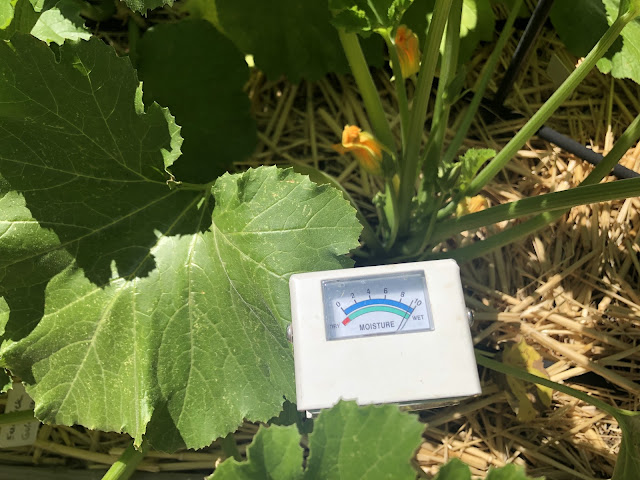
Master gardener advice on how to keep your garden thriving this hot, dry summer

|
| The moisture meter shows that this squash plant is in good shape to handle a heat wave. It's drip-watered and is mulched with straw. (Photo: Kathy Morrison) |
Tuesday’s first day of summer likely was a taste of days to come: Hot and dry.
To start this new season, Sacramento will see a string of triple-digit days; that’s normal for August but not June.
In addition, we’re in a three-year drought. Water restrictions may be coming statewide.
Can your vegetable garden be saved?
Yes! Any vegetable can be grown with less water by following some simple water-wise tips, says UCCE Sacramento County master gardener Gail Pothour.
Water-saving methods are on display at the master gardeners’ Fair Oaks Horticulture Center. Pothour is an expert and former project leader in the vegetable garden. These same tips will help your plants thrive in summer heat.
– Switch to drip; it saves water while improving efficiency. “Drip irrigation is highly recommended,” Pothour says. “It puts water where it’s needed – at the roots. Hand watering is OK for new seedlings.”
– Cycle and repeat. When using drip or above-ground irrigation, run a cycle, let it soak in, then run again. “That way, you have a lot less runoff and don’t waste water,” Pothour says.
– Mulch, mulch, mulch! A 3-inch blanket of organic mulch (straw, leaves, wood chips) holds in soil moisture, cuts down on evaporation and keeps plant roots comfortable. It also cuts down on weeds.
– Before planting, build your soil with organic amendments such as compost. The organic material acts like a sponge and retains moisture. The soil is less likely to dry out, even with reduced irrigation.
– Prioritize what you water. “Fruit trees and blueberries are probably the most valuable edible plants you have,” Pothour says. “They’re expensive to replace and take a long time to grow. Make sure they get deep-watered.”
– Cut back on fertilizer. “Adding fertilizer stimulates growth that will need more water,” she explains. “Use low-nitrogen fertilizers.”
– Always check soil before watering. Does it really need it? Use a moisture meter or long screwdriver to test. “Most gardeners over-water,” Pothour says. “Even in our demonstration gardens, we discovered we could cut our water use significantly just by checking the soil and paying attention.”
Comments
0 comments have been posted.Sacramento Digs Gardening to your inbox.
Sites We Like
Garden Checklist for week of July 21
Your garden needs you!
* Keep your vegetable garden watered, mulched and weeded. Water before 8 a.m. to reduce the chance of fungal infection and to conserve moisture.
* Feed vegetable plants bone meal, rock phosphate or other fertilizers high in phosphate to stimulate more blooms and fruiting. (But wait until daily high temperatures drop out of the 100s.)
* Don’t let tomatoes wilt or dry out completely. Give tomatoes a deep watering two to three times a week.
* Harvest vegetables promptly to encourage plants to produce more. Squash especially tends to grow rapidly in hot weather. Keep an eye on zucchini.
* Pinch back chrysanthemums for bushy plants and more flowers in September.
* Remove spent flowers from roses, daylilies and other bloomers as they finish flowering.
* Pinch off blooms from basil so the plant will grow more leaves.
* Cut back lavender after flowering to promote a second bloom.
* It's not too late to add a splash of color. Plant petunias, snapdragons, zinnias and marigolds.
* From seed, plant corn, pumpkins, radishes, winter squash and sunflowers.